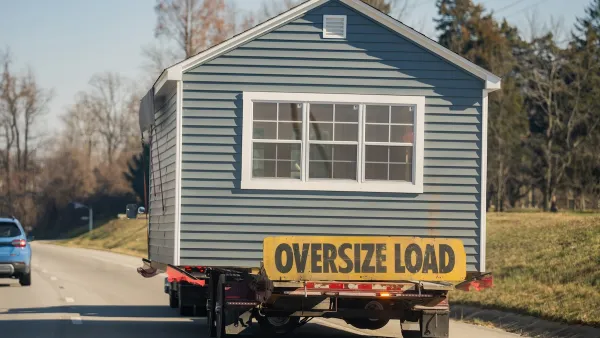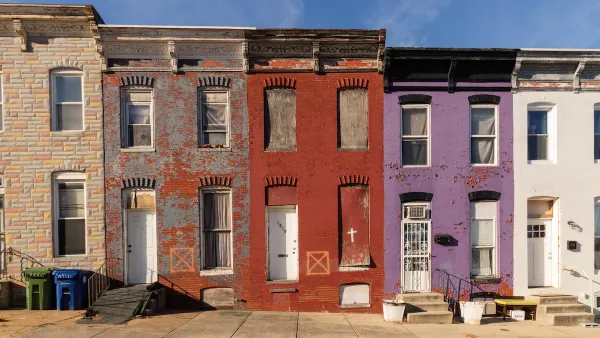Scrambling to grab that elusive “American Dream” of homeownership, millions plunged into the subprime mortgage market to build wealth through appreciation (if not speculation). Pundits cheered as the ownership rate crept up, lauding the pluck of aspirational minority and immigrant families.There’s a reason it is called subprime, though. Lenders offered a smorgasborg of loan “products,” but the bottom line was that they are all very costly for the borrower – often entailing adjustable-rate surprises in the 30 percent or higher range.
Scrambling to grab that elusive "American Dream" of homeownership, millions plunged into the subprime mortgage market to build wealth through appreciation (if not speculation). Pundits cheered as the ownership rate crept up, lauding the pluck of aspirational minority and immigrant families.
There's a reason it is called subprime, though. Lenders offered a smorgasborg of loan "products," but the bottom line was that they are all very costly for the borrower – often entailing adjustable-rate surprises in the 30 percent or higher range.
With prices flat and interest rates creeping up, defaults on subprime loans are skyrocketing, with many borrowers falling behind after just a few months. The lenders who have not yet filed for bankruptcy are stampeding to the exits. A great number of them, though, took billions out of these businesses before they went belly-up.
the real cost will be born by the borrowers, who have no financial cushion. They had hoped that home appreciation would build some wealth. Wages, by and large, have not done the job even with a growing economy.
Their communities will also pay. A lot of those subprime buyers have snapped up the little ranches and Cape Cods in the 1950s inner suburbs, giving a new lease on life to communities that professionals and more affluent buyers have skipped over. Though the houses in these cul de sacs can still look neat, with their hedges and lawns nicely clipped, many of these communities have stagnated, sunk into poverty, or hovered at the tipping point for years. Even modest appreciation would solidify middle-income status for struggling wage earners, but the outlook now is for slippage, possibly long-term price drops.
As the pain spreads, there will be much handwringing and fingerpointing (assuming it does not incite a broader market meltdown as some fear). But the warning bells were rung early and often. No one in Congress, at Freddie Mac, Fannie Mae, or in the mortgage industry should have been unaware of the lax regulation and the likelihood of high levels of defaults. But the pickings were too lush, and the lobbying largesse was spread too thick.
And when things stabilize, the mess will get swept under the rug, because, after all, maybe a few hundred thousand borrowers, or a few million – as in the similarly greed-driven savings and loan collapse in the late 1980s – will be hurt, and they'll be largely invisible because they don't stroll the board rooms of banks or live in the nice neighborhoods of media executives.
There used to be names for this kind of thing, though. One was fraud and the other was usury. Maybe our language will be enriched by them again.

Analysis: Cybertruck Fatality Rate Far Exceeds That of Ford Pinto
The Tesla Cybertruck was recalled seven times last year.

National Parks Layoffs Will Cause Communities to Lose Billions
Thousands of essential park workers were laid off this week, just before the busy spring break season.

Retro-silient?: America’s First “Eco-burb,” The Woodlands Turns 50
A master-planned community north of Houston offers lessons on green infrastructure and resilient design, but falls short of its founder’s lofty affordability and walkability goals.

Test News Post 1
This is a summary

Analysis: Cybertruck Fatality Rate Far Exceeds That of Ford Pinto
The Tesla Cybertruck was recalled seven times last year.

Test News Headline 46
Test for the image on the front page.
Urban Design for Planners 1: Software Tools
This six-course series explores essential urban design concepts using open source software and equips planners with the tools they need to participate fully in the urban design process.
Planning for Universal Design
Learn the tools for implementing Universal Design in planning regulations.
EMC Planning Group, Inc.
Planetizen
Planetizen
Mpact (formerly Rail~Volution)
Great Falls Development Authority, Inc.
HUDs Office of Policy Development and Research
NYU Wagner Graduate School of Public Service





























